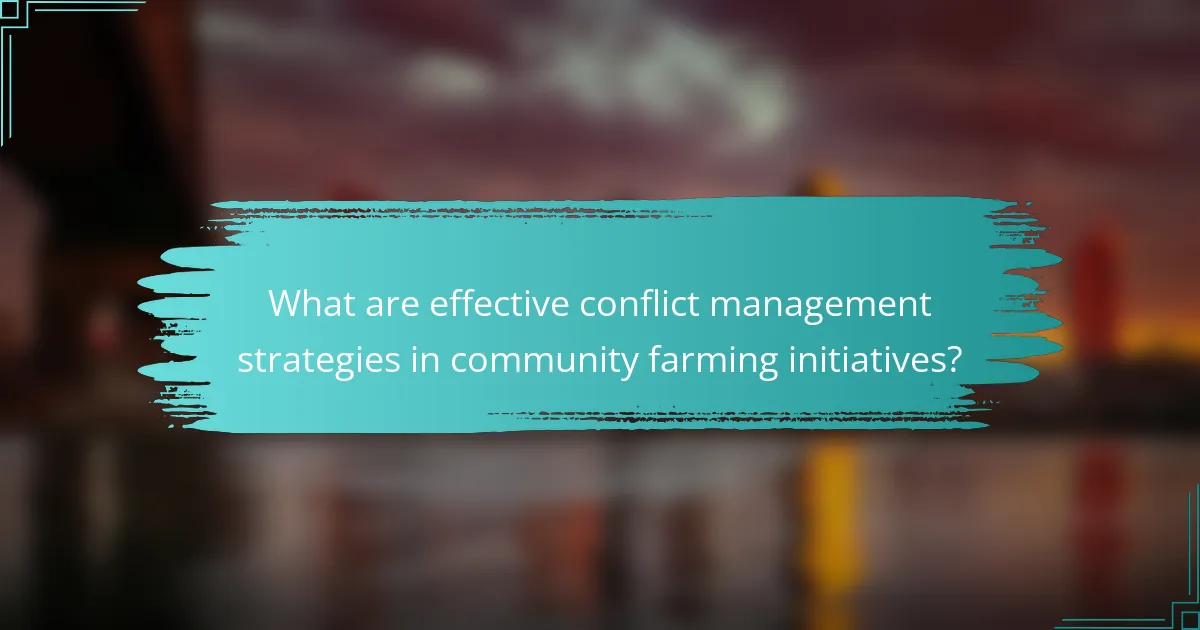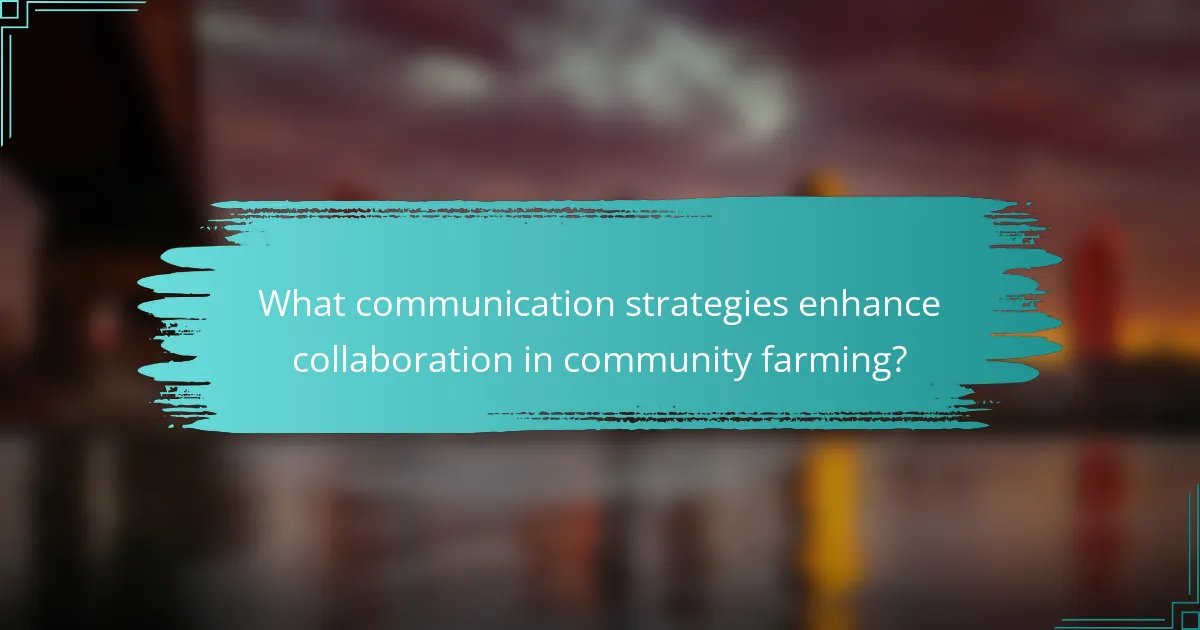Community farming initiatives thrive on effective conflict management, participant engagement, and robust communication strategies. By emphasizing proactive communication and collaborative problem-solving, these initiatives create a constructive environment that encourages active participation. Engaging members through inclusive opportunities and fostering a sense of ownership further enhances collaboration and trust among participants.

What are effective conflict management strategies in community farming initiatives?
Effective conflict management strategies in community farming initiatives focus on proactive communication, collaborative problem-solving, and structured mediation. These approaches help participants address disagreements constructively, fostering a positive environment for all involved.
Mediation techniques
Mediation techniques involve neutral third parties facilitating discussions between conflicting parties to reach a mutually agreeable solution. Techniques such as active listening, reframing issues, and exploring interests rather than positions can significantly enhance understanding and cooperation. Community farms might implement informal mediation sessions to address disputes before they escalate.
Common mediation techniques include brainstorming solutions together and establishing ground rules for respectful dialogue. These methods encourage participants to express their concerns while working collaboratively towards resolution.
Conflict resolution frameworks
Conflict resolution frameworks provide structured approaches to managing disputes effectively. Popular models include the Interest-Based Relational Approach and the Thomas-Kilmann Conflict Mode Instrument, which help participants identify their conflict styles and underlying interests. These frameworks guide community members in navigating conflicts by emphasizing collaboration over competition.
Implementing a framework can involve training sessions for participants, ensuring everyone understands the process and feels equipped to engage in conflict resolution. This preparation can lead to more productive discussions and outcomes.
Role of facilitators
Facilitators play a crucial role in managing conflicts within community farming initiatives by guiding discussions and ensuring that all voices are heard. They help create a safe space for dialogue, encouraging openness and trust among participants. Effective facilitators are skilled in neutrality and can navigate sensitive topics without taking sides.
Facilitators can also help set agendas, clarify misunderstandings, and summarize key points during discussions. Their involvement often leads to more effective communication and a higher likelihood of reaching consensus.
Case studies from urban farms
Case studies from urban farms illustrate successful conflict management strategies in action. For example, a community garden in a major city implemented regular mediation workshops, resulting in a significant reduction in disputes over shared resources. Participants reported feeling more empowered to address issues before they escalated.
Another urban farm utilized a conflict resolution framework to address disagreements about land use. By involving all stakeholders in the decision-making process, they achieved a sustainable solution that satisfied diverse interests, demonstrating the effectiveness of structured approaches in real-world scenarios.

How can participant engagement be improved in community farming?
Improving participant engagement in community farming involves creating inclusive opportunities for involvement and fostering a sense of ownership among members. Strategies such as workshops, incentive programs, and feedback mechanisms can significantly enhance participation and collaboration.
Workshops and training sessions
Workshops and training sessions are effective ways to engage participants by providing them with valuable skills and knowledge. These sessions can cover topics such as sustainable farming practices, crop management, and community organization. Scheduling these workshops regularly, perhaps monthly, can help maintain interest and build a knowledgeable community.
Consider inviting local experts or experienced farmers to lead these sessions, as their insights can motivate participants and enhance learning. Additionally, offering hands-on activities during workshops can increase engagement and retention of information.
Incentive programs
Incentive programs can boost participant engagement by rewarding active involvement in community farming initiatives. These incentives might include discounts on produce, free seeds, or even small monetary rewards for contributions like volunteering time or resources. Establishing a points system where participants earn rewards based on their engagement can create a friendly competitive atmosphere.
When designing incentive programs, ensure they are accessible and appealing to all participants. Tailoring rewards to the preferences of the community can enhance motivation and participation rates.
Feedback mechanisms
Implementing feedback mechanisms allows participants to voice their opinions and suggestions, fostering a sense of belonging and investment in the community farming initiative. Regular surveys or suggestion boxes can be effective tools for gathering input on various aspects of the program, from crop selection to event planning.
It’s essential to act on the feedback received to demonstrate that participant opinions are valued. This can lead to improved practices and increased engagement, as members see their contributions making a tangible difference in the community farming efforts.

What communication strategies enhance collaboration in community farming?
Effective communication strategies are essential for fostering collaboration in community farming initiatives. These strategies help build trust, facilitate information sharing, and engage participants actively in the farming process.
Digital communication tools
Digital communication tools, such as email, messaging apps, and project management platforms, streamline collaboration among community farmers. These tools allow for real-time updates, task assignments, and sharing of resources, making it easier to coordinate activities and address issues promptly.
Consider using platforms like Slack or Trello to organize tasks and discussions. Ensure that all participants are familiar with these tools to maximize their effectiveness and reduce confusion.
Regular community meetings
Regular community meetings provide a structured opportunity for participants to discuss progress, share concerns, and plan future activities. These meetings can be held weekly or monthly, depending on the community’s needs and the scale of the farming initiative.
To enhance engagement, rotate meeting locations among members’ farms or community centers. This not only fosters a sense of ownership but also allows participants to showcase their contributions and share best practices.
Social media engagement
Social media platforms are powerful tools for engaging the broader community and attracting new participants to farming initiatives. By sharing updates, success stories, and upcoming events on platforms like Facebook or Instagram, communities can increase visibility and foster a sense of belonging.
Encourage participants to share their experiences and tag the community’s social media accounts. This not only boosts engagement but also creates a vibrant online presence that can draw in support and resources from outside the immediate community.

What are the prerequisites for successful community farming initiatives?
Successful community farming initiatives require a clear understanding of local needs, effective stakeholder engagement, and strong communication strategies. These elements help ensure that projects are relevant, inclusive, and sustainable.
Community needs assessment
A community needs assessment identifies the specific requirements and interests of local residents regarding farming initiatives. This process typically involves surveys, interviews, and focus groups to gather input from potential participants.
Consider factors such as available land, local agricultural practices, and community demographics. For example, a community with a high percentage of families may prioritize educational programs for children, while urban areas might focus on small-scale gardening projects.
Regularly revisiting the needs assessment can help adapt initiatives to changing community dynamics and preferences, ensuring ongoing relevance and engagement.
Stakeholder mapping
Stakeholder mapping involves identifying all individuals and groups that have a vested interest in the community farming initiative. This includes farmers, local businesses, government agencies, and community organizations.
Creating a visual map can help clarify relationships and influence levels among stakeholders. For instance, local schools may serve as partners for educational outreach, while local government can provide necessary permits and support.
Engaging stakeholders early in the planning process fosters collaboration and can mitigate potential conflicts, leading to a more cohesive and successful initiative.

How do local regulations impact community farming initiatives?
Local regulations play a crucial role in shaping community farming initiatives by dictating what can be done on specific land parcels. These regulations can either facilitate or hinder the establishment and operation of community farms, depending on their nature and enforcement.
Zoning laws
Zoning laws determine how land can be used in a specific area, which directly affects community farming initiatives. In many regions, agricultural activities may be restricted to certain zones, limiting where community farms can be established. For instance, urban areas may have stricter zoning regulations that prioritize residential or commercial development over agricultural use.
Community farming groups should familiarize themselves with local zoning ordinances to identify suitable locations. Engaging with local planning authorities can provide insights into potential zoning changes or variances that may allow for farming activities in non-agricultural zones.
Permitting processes
Permitting processes are essential for ensuring that community farming initiatives comply with local laws and regulations. These processes often require farmers to obtain various permits, such as land use permits, health permits, or building permits for structures like greenhouses. The complexity and duration of these processes can vary significantly by location.
To navigate permitting effectively, community farming groups should start early and gather all necessary documentation. It’s beneficial to create a checklist of required permits and consult with local government offices to understand specific requirements. Being proactive can help avoid delays and ensure compliance with local regulations.

What are the emerging trends in community farming communication?
Emerging trends in community farming communication focus on enhancing participant engagement, fostering collaboration, and utilizing technology for effective information sharing. These trends emphasize transparency, inclusivity, and the use of digital platforms to streamline communication among participants.
Conflict Management Strategies
Effective conflict management in community farming initiatives involves proactive communication and mediation techniques. Establishing clear guidelines and expectations from the outset can help prevent misunderstandings and disputes. Regular check-ins and open forums for discussion allow participants to voice concerns before they escalate.
Utilizing neutral facilitators during conflicts can provide an unbiased perspective and help mediate discussions. It’s essential to focus on common goals and interests rather than individual positions, which can lead to more constructive resolutions.
Participant Engagement Techniques
Engaging participants in community farming requires creating a sense of ownership and belonging. Regular workshops, hands-on activities, and social events can foster a strong community spirit and encourage active participation. Providing opportunities for feedback and input on decisions enhances engagement and investment in the initiative.
Utilizing surveys or suggestion boxes can help gather participant insights and preferences, ensuring everyone feels heard. Incorporating gamification elements, such as rewards for participation, can also motivate individuals to get involved.
Communication Strategies
Effective communication strategies in community farming initiatives should prioritize clarity and accessibility. Utilizing multiple channels, such as social media, newsletters, and community boards, ensures that information reaches all participants. Visual aids, like infographics or charts, can simplify complex information and enhance understanding.
Regular updates on project progress and upcoming events keep participants informed and engaged. Establishing a dedicated communication team can help manage these efforts and ensure consistent messaging across all platforms.
